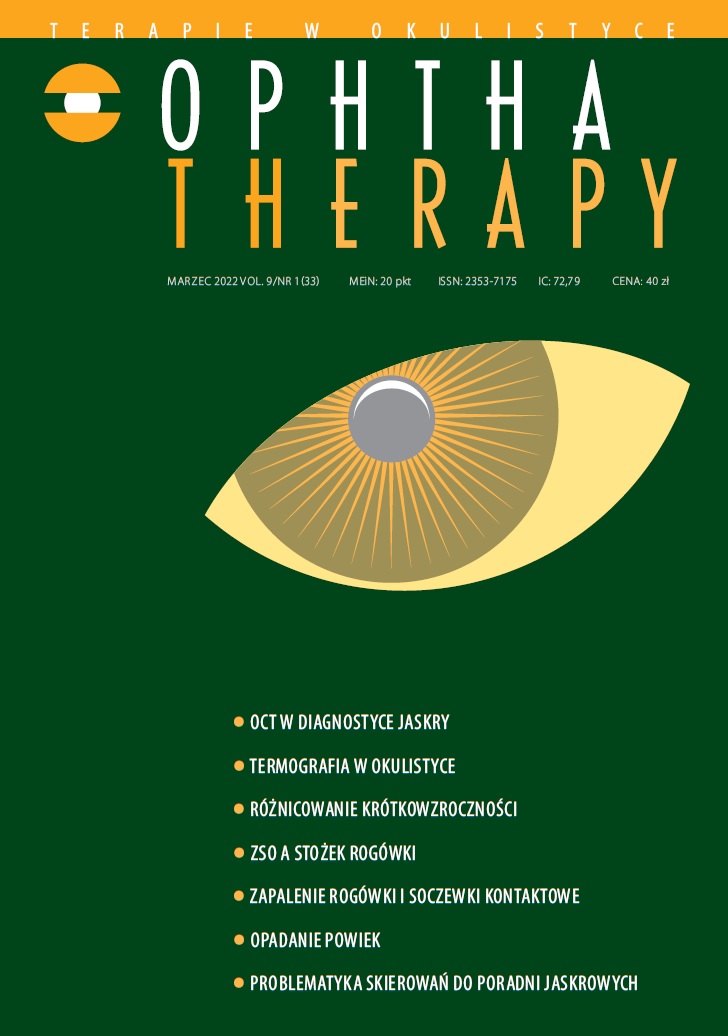Ptoza – opadnięcie powieki górnej. Diagnostyka i leczenie Artykuł przeglądowy
##plugins.themes.bootstrap3.article.main##
Abstrakt
Szacuje się, że niskie ustawienie powieki górnej dotyczy w Polsce ponad 1 mln pacjentów. Ptoza ogranicza pole widzenia, powoduje wyrównawcze ustawienia głowy i odczucie pogorszenia widzenia. Nieestetyczny wygląd oczu wpływa dodatkowo na niską samoocenę osób dotkniętych opadnięciem powiek. Celem artykułu jest przegląd współczesnych algorytmów diagnostycznych stosowanych w przypadku opadniętej powieki. W pracy omówiono również techniki operacyjne, które są stosowane w ptozie, oraz wskazówki dotyczące prawidłowego kwalifikowania chorego do danej metody operacyjnej.
Pobrania
##plugins.themes.bootstrap3.article.details##

Utwór dostępny jest na licencji Creative Commons Uznanie autorstwa – Użycie niekomercyjne – Bez utworów zależnych 4.0 Międzynarodowe.
Copyright: © Medical Education sp. z o.o. License allowing third parties to copy and redistribute the material in any medium or format and to remix, transform, and build upon the material, provided the original work is properly cited and states its license.
Address reprint requests to: Medical Education, Marcin Kuźma (marcin.kuzma@mededu.pl)
Bibliografia
2. Forman WM, Leatherbarrow B, Sridharan GV et al. Acommunity survey of ptosis of the eyelid and pupil size of elderly people. Age Ageing. 1995; 24: 21-4.
3. Farber SE, Codner MA. Evaluation and management of acquired ptosis. Plast Aesthet Res. 2020; 7: 20.
4. Potemkin VV, Goltsman EV. Algorithm of objective examination of a patient with blepharoptosis. Ophthal J. 2019; 12(1): 45-51.
5. Grob SR, Cypen SG, Tao JP. Acquired Ptosis. Springer Nature Switzerland AG 2020.
6. Pauly M, Sruthi R. Ptosis: Evaluation and management. Kerala J Ophthalmol. 2019; 31: 11-6.
7. Nair AG, Patil-Chhablani P, Venkatramani D et al. Ocular myasthenia gravis: A review. Indian J Ophthalmol. 2014; 62(10): 985-91.
8. Monsul NT, Patwa HS, Knorr AM et al. The effects of prednisone on the progression from ocular to generalized myasthenia gravis. J Neurol Sci. 2004; 217: 131-3.
9. Jones LT, Quickert MH, Wobig JL. The cure of ptosis by aponeurotic repair. Arch Ophthalmol. 1975; 93: 629-34.
10. Anderson RL, Dixon RS. Aponeurotic ptosis surgery. Arch Ophthalmol. 1979; 97: 1123-8.
11. Laplant JF, Kang JY, Cockerham KP. Ptosis repair: external levator advancement vs. Muller’s muscle conjunctiva resection – techniques and modifications. Plast Aesthet Res. 2020; 7: 60.
12. Liao SL, Chuang AY. Various Modifications on Müller’s Muscle-Conjunctival Resection for Ptosis Repair. Arch Aesthetic Plast Surg. 2015; 21(2): 31-6.
13. Shubhra G, Cat Nguyen B. Expert Techniques in Ophthalmic Surgery; Chapter-61 Ptosis Repair: Müllerectomy 2019.
14. Fasanella RM, Servat J. Levator resection for minimal ptosis: another simplified operation. Arch Ophthalmol. 1961; 65: 493-6.
15. Beard C. The surgical treatment of blepharoptosis: a quantitative approach. Trans Am Ophthalmol Soc. 1966; 64: 401-5.
16. Putterman AM, Urist MJ. Müller’s muscle-conjunctival resection. Arch Ophthalmol. 1975; 93(8): 619-23.
17. Crawford JS. Repair of blepharoptosis with a modification of the Fasanella-Servat operation. Can J Ophthalmol. 1973; 8: 19-23.
18. Patel RM, Aakalu VK, Setabutr P et al. Efficacy of Muller’s Muscle and Conjunctiva Resection With or Without Tarsectomy for the Treatment of Severe Involutional Blepharoptosis. Ophthalmic Plast Reconstr Surg. 2017; 33(4): 273-8.

